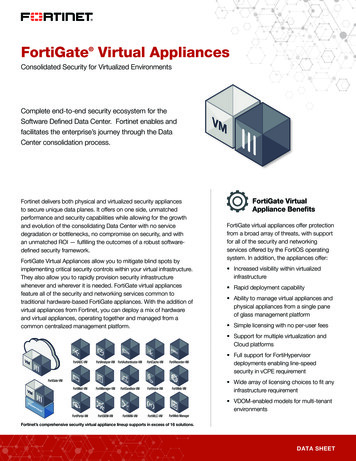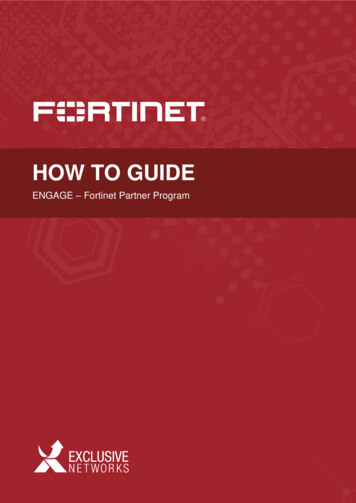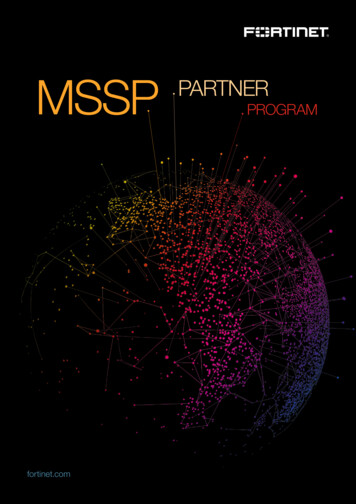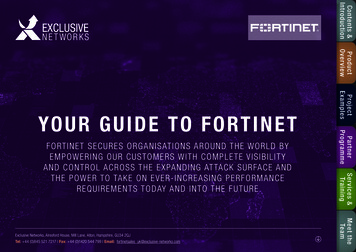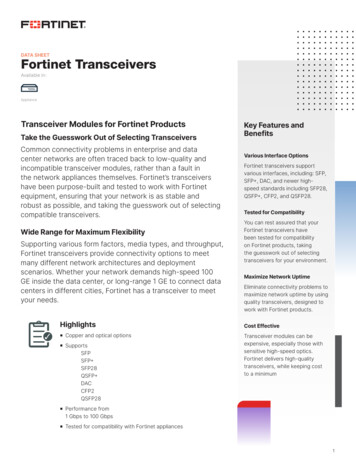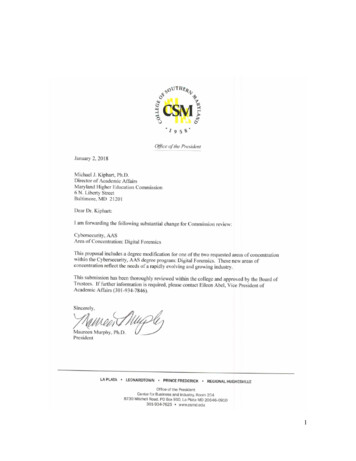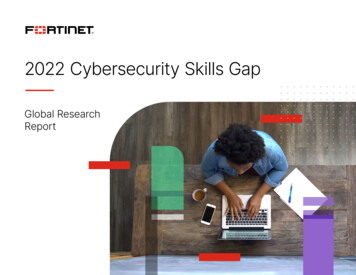
Transcription
2022 Cybersecurity Skills GapGlobal ResearchReport
Contents04 INTRODUCTIONIs the cybersecurity workforce growingfast enough to keep up with new threats?06EXECUTIVE SUMMARYHow the cybersecurity workforce is growing07About the research08Cybersecurity affects every organization10Recruitment and retention of talent is a problem14 Organizations are looking for individuals withcertified skills15Organizations are looking for more diversity17 Raising cybersecurity awareness remainsa key challenge18CONCLUSIONThe power of people19About Fortinet02
Fortinet 2022 Cybersecurity Skills Gap Global Research ReportThe impact of the cybersecurity skills gapNew cyber research onkey concerns, recruitment,diversity, and securityawareness03
Fortinet 2022 Cybersecurity Skills Gap Global Research ReportINTRODUCTIONIs the cybersecurity workforce growing fastenough to keep up with new threats?During the last two years, IT teams were forced to rapidly adapt toremote and hybrid work models. While the effort was challenging,the ability to adapt was a safeguard for most organizations.Unfortunately, increases in remote and hybrid work modelsresulted in the expansion of the threat landscape. IT teamshad to act quickly to deal with an increasingly harsh reality.“Cybercriminals are developing attacks fasterthan ever. They continue to exploit the expandingattack surface of hybrid workers and IT. Andthey’re using advanced persistent cybercrimestrategies that are more destructive and lesspredictable than those in the past.”—Derek Manky, Chief Security Strategist & VP Global ThreatIntelligence, FortiGuard LabsThe sudden expansion of the corporate network, where millions ofemployees were logging in from their unsecured home offices, ledto significant spikes in malicious cyber activity. In 2021, the FortinetGlobal Threat Landscape Report revealed a tenfold increase inransomware attacks alone.According to a new Fortinet-sponsored survey, it’s clear that manyof the challenges organizations face in combating cybercrime aredirectly related to a lack of qualified cybersecurity professionals.1Global Threat Landscape Report 2021, FortinetFortinet Blog04
Fortinet 2022 Cybersecurity Skills Gap Global Research ReportWorldwide, 80% of organizations suffered one or morebreaches that they could attribute to a lack of cybersecurityskills and/or awareness.Here are a few examples:The survey shows that 64% of organizationsexperienced breaches that resulted in lostrevenue and/or cost them fines during thepast year. A staggering 38% of organizationsreported breaches that cost them morethan a million dollars (USD).A key factor is that organizations struggle to find and retaincertified cybersecurity people. Global leaders indicate that: 60% struggle to recruit cybersecurity talent 52% struggle to retain qualified people 67% agree that the shortage of qualified cybersecuritycandidates creates additional risks for their organizationsOrganizations need qualified cybersecurity professionals nowmore than ever, which is why 76% of organizations indicate thattheir board of directors now recommends increases in IT andcybersecurity headcount.In this report, we analyze the results from our survey to explorefive central themes about why the current cybersecurity skillsgap matters, and how organizations are attempting to fill it.They’re not wrong.05
Fortinet 2022 Cybersecurity Skills Gap Global Research ReportEXECUTIVE SUMMARYHow the cybersecurity workforce is growingCybersecurityaffects everyorganization80% of organizationsexperienced one or morebreaches during the last12 months.19% confirm five ormore breaches.Almost 40% sufferedbreaches that cost morethan a million dollars USDto remediate.Recruitment andretention of talentis a problem67% of respondents agreethat the skills shortagecreates additionalcyber risks for theirorganization. As such,76% of organizations nowhave a board of directorswho explicitly recommendincreases in IT andcybersecurity headcount.However, 60% oforganizations struggle torecruit cybersecurity talentand 52% struggle to retain it.Organizationsare looking forindividuals withcertified skillsOrganizationsare looking formore diversity95% of decision-makersbelieve technology-focusedcertifications positivelyimpact both their role andtheir team. As such, 81%of leaders prefer to hirepeople with certifications.7 out of 10 leaders worldwidesay hiring women and newgraduates are among theirtop three challenges.However, 78% indicateit’s hard to find certifiedpeople, which is why 91%of organizations are willingto pay for the trainingand certification of theiremployees.61% say hiring minorities isalso a top three challenge.Despite the challenges,or perhaps because of it,3 out of 4 organizationsimplemented formalprocesses to hire morewomen, and 9 out of 10actively engaged womenand new graduates duringthe last three years.Raising cybersecurityawareness remainsa key challenge87% of organizationsimplemented a trainingprogram to increase cyberawareness. However, 52%of leaders continue tobelieve their employeesstill lack the necessaryknowledge. This raisesthe question of theeffectiveness of theseprograms.66% of organizations thatdon’t have a programintend to set one up.06
Fortinet 2022 Cybersecurity Skills Gap Global Research ReportAbout the researchThe survey was conducted among 1223 IT andcybersecurity decision-makers located ng KongTheNetherlandsPeople’sRepublic ofChinaThe PhilippinesNew ZealandSingaporeSouth AfricaSouth KoreaSpainSwedenTaiwanThailandUnited ArabEmiratesUnitedKingdomUnited Statesof AmericaRespondents came from a range of industries.The best represented were technology (28%),manufacturing (12%), and financial services (10%).Respondents came from organizations of various sizes:In addition:100-499 employees: 22%12% of respondents are owners500-999 employees: 24%34% hold C-level executive positions1,000-2,499 employees: 23%6% are vice presidents2,500-4,999 employees: 16%5,000 employees: 15%14% are department heads34% are directors64% are male35% are female07
Fortinet 2022 Cybersecurity Skills Gap Global Research ReportCybersecurity affects every organizationWhen organizations don’t have the qualifiedcybersecurity talent they need, they become morevulnerable to attacks. The data bears this out, withtwo-thirds of leaders (67%) worldwide expressingconcern about the additional risks they face due tothe skills gap within their organization.Leaders on every continent sharethis concern eaders from France (81%), North America (77%),Land Hong Kong (77%) show the highest level ofconcern and believe that skills shortages poseadditional risks to their organization.Whereas only half of the leaders from Indonesia(50%), Italy (50%), and Israel (47%) indicate concern.08
Fortinet 2022 Cybersecurity Skills Gap Global Research ReportGlobally, 88% of organizations that have a board of directorsreport that their board now asks questions specificallyabout cybersecurity.Cybersecurity is now a board-level priorityGiven the increasing and tangible costs of breaches, cybersecurityis becoming a board-level priority. Globally, 88% of organizationsthat have a board of directors report that their board now asksquestions specifically about cybersecurity.As a result of these discussions, 76% of boards of directors globallyare suggesting an increased headcount for IT and cybersecurity.For example, USA (90%) organizations discuss cybersecurity with their board,and 77% of those boards recommend an increase in headcountin IT and security. Indian (100%) and Chinese (96%) organizations discusscybersecurity with their boards. Given the high number of breachesin these countries, it is not surprising that 92% of Indian boards and100% of Chinese boards recommend an increase in headcount inIT and security.09
Fortinet 2022 Cybersecurity Skills Gap Global Research ReportRecruitment andretention of talentis a problemRetention: the critical challengeWhen there’s a lack of qualified professionals in the pipeline, there’sonly so many things that organizations can do to grow their workforce.For companies to reliably protect themselves in the long run, the mostimportant thing they can do is focus on retaining their best people.Globally, 52% of leaders admit their organization struggles toretain cybersecurity talent. However, there are significantregional differences:Hiring challengesIt is difficult to find and recruit qualified cybersecurity professionals.Globally, 60% of leaders admit their organizations struggle withrecruitment. Thailand (91%), Brazil (84%), and Israel (80%) report significantissues with retention. Italy (30%), Mexico (28%), and People's Republic of China (25%)report fewer issues.Further analysis shows that it is a far bigger problem for somethan for others: Brazil (97%), France (77%), and North America (69%)struggle with hiring. People’s Republic of China (33%) and Spain (29%)report fewer issues.This may be due to the number of qualified cybersecurityprofessionals available in these regions. It’s likely also influencedby the maturity of the cybersecurity industry within each region.10
Fortinet 2022 Cybersecurity Skills Gap Global Research ReportWhat is the most significant skills gap?A key challenge for organizations seeking cybersecurity talent is that theyneed to hire people for a broad range of security and IT network-relatedroles and specializations.What roles are organizations looking for?50%Cloud Security SpecialistSecurity Operations (SOC) Analysts42%Security Administrators42%40%Security Architects37%Security Awareness and Training Administrators34%Network ArchitectsDevSecOps Specialists32%Incident Response Specialists32%Compliance Specialists27%Penetration Testers27%21%NOC OperatorsOther1%11
Fortinet 2022 Cybersecurity Skills Gap Global Research ReportThe challenge is finding the right peopleCloud security specialists and security operations(SOC) analysts remain among the most sought-afterroles in cybersecurity, followed closely by securityadministrators and architects. But organizationsaren’t just looking to ramp up hires arbitrarily. They’redeliberately trying to build teams of specializedtalent who are equipped to handle an increasinglycomplex threat landscape.Globally, 50% of organizations seek cloud securityspecialists, a priority that’s likely informed by howrapidly companies moved their operations to thecloud during the pandemic.The challenge is finding the right people.Which are the hardest roles to fill?Cloud Security (cloud and data center,application security, etc.)57%Security Operations (SOC platforms, advancethreat protection, endpoint security, etc.)50%49%Network Security (firewall, WAN edge, etc.)42%Software Development Security38%Risk Management34%Security Assessment and Testing22%Access Management19%ComplianceNone of the above5%12
Fortinet 2022 Cybersecurity Skills Gap Global Research ReportGlobally, cloud security (57%) and security operations (50%)are the most challenging areas to recruit into, followedby technical roles in network and software development–related security.In North America, it was slightly higher, with 63% and 57% ofleaders respectively listing cloud security and security operationsas the two most challenging roles to fill. The greatest strugglescame from Thailand (87%), People's Republic of China (79%),and Indonesia (73%).13
Fortinet 2022 Cybersecurity Skills Gap Global Research ReportOrganizations are looking for individualswith certified skillsCentral to the challenge of recruiting and retaining cybersecuritytalent is the importance of certification. Certified professionalsare universally sought after. Globally, 91% of organizationsclaim they are willing to pay for an employee to achieve acybersecurity certification.It is no surprise that 81% look forpeople with certifications when hiring.In India and People's Republic of China, certifications are especiallysought after with 100% of leaders looking for certified peoplewhen hiring. In North America, 85% of organizations are reportinga preference to hire certified people.The preference to hire certified people may be becauseorganization leaders followed that same path themselves: 86% of decision-makers report having earned technologyfocused certifications. 88% report having other people with certifications on their team.What impacts have certifications made?Increased cybersecurityawareness and knowledge,and perform duties better79%Faster career growth / promotionHigher salarySecure a job34%29%23%For companies with fewer than 499 employees, 78% of decision-makersare certified in some way, while at companies with more than 1,000employees, 89% of leaders have certifications. It is no surprise that81% look for people with certifications when hiring.However, finding certified professionals is not the same for each region.For example: Argentine (95%), Japanese (88%), and Brazilian (87%) organizationsreport having difficulty finding certified talent. Whereas Australian (62%) and Hong Kong (68%) leaders havefewer difficulties.14
Fortinet 2022 Cybersecurity Skills Gap Global Research ReportOrganizations are lookingfor more diversityThe challenge isn’t just hiring more people, but also building morecapable and more diverse teams. While enterprises need qualifiedtalent for a range of different roles, 89% of global companies alsohave explicit diversity goals as part of their hiring plan.Globally, 70% of IT managers see the recruitment of women andnew graduates as a top three challenge. Organizations in LatinAmerica (93%) and North America (90%) are more likely to havediversity goals in place, likely as a result of bigger strugglesrecruiting from these populations.Is hiring from these populations one ofyour organization’s top three challenges?YesNoNew 53%47%Hiring a diverse team is more than just intent. Organizations are activelyand strategically changing their hiring structures to promote morediverse talent. For example, 75% of organizations report having formalstructures to recruit more women, and 89% have intentionally setdiversity goals when hiring new graduates.While fewer organizations report having hiring processes designedto attract more minorities and veterans, they are still present inmost organizations: 59% of companies have structures in place to hire minorities,and 51% for hiring more veterans. 64% and 52% of organizations in North America have put structuresin place to hire minorities and veterans respectively, while in EMEA,56% and 48% have these structures in place.15
Fortinet 2022 Cybersecurity Skills Gap Global Research ReportThere are challengesNew graduates are the easiest to hire, with only 24% of decisionmakers reporting that they’ve found it difficult. By comparison,33%, so exactly one-third, of North American organizations saythey have difficulties hiring minorities, which is considerably lowerthan 43% of organizations in Asia Pacific.However, 45% of organizations report that it’s challenging to findqualified veterans, with 18% going so far as to say it’s very difficult.Decision-makers also feel that hiring individuals from these groups isjust as difficult now as before the pandemic, with some noteworthydistinctions. For example, more women seem to be joining the ranksof the cybersecurity workforce, with 24% of organizations reportingthey’ve found it easier to hire women since the pandemic.Nonetheless, companies are continuing theirefforts to hire more diverse teamsOver the last three years: 88% of organizations report having actively hired more women 87% actively seek to meet diversity goals when hiring new graduates 67% have actively hired minorities 53% have deliberately sought out veteransMost importantly, most of these companies report having members ofthese groups in their C-suite team.Population in C-suite In addition: 89% of executive teams include women 57% include minorities 55% have veterans on their executive teams 72% of women performing these roles have been doing so formore than five years, with 26% doing so for more than 10 80% of veterans have been in C-suite roles for more than five years 18% of veterans in C-suite roles only began in the last five yearsUnsurprisingly, the larger an organization is, the likelier it is to havewomen, minorities, and veterans represented in the C-suite.24% of organizations report they’ve found it easier to hire women since the pandemic.16
Fortinet 2022 Cybersecurity Skills Gap Global Research ReportRaising cybersecurity awarenessremains a key challengeEven though the recruitment, retention, and certification of acybersecurity team is vital, companies cannot realistically protectthemselves until they also raise the cyber awareness of all employees.That requires ensuring that all employees, at all levels and all roleswithin the organization, have the knowledge and awareness toprotect themselves and their organization’s data. Until they do,breaches will always be likely.The value of awareness programsAsian (56%) leaders feel employees lack the necessary awareness.Worryingly, federal governments (69%) and state-level governmentorganizations (61%) feel the same way. Interestingly, local and stategovernment organizations (28%) and media organizations (25%)are the most likely to not have cybersecurity awareness programsin place.For those that don’t have a program in place, 66% report theyare currently looking for a program that would suit their needs.Interestingly, 87% of organizations implemented a trainingprogram to increase cyber awareness. However, 52% of leaderscontinue to believe their employees still lack the necessaryknowledge. This raises the question of the effectiveness ofprograms currently in place.On the other hand, Sweden (63%) and South Africa (60%) believe theiremployees do have the necessary level of cybersecurity awareness.17
Fortinet 2022 Cybersecurity Skills Gap Global Research ReportCONCLUSIONThe power of peopleCybersecurity can sometimes feel like a purely technological domain.But when you look past the technology that organizations rely on,cybersecurity is all about how well your employees work togetherto protect the organization.The challenge for organizations is multi-facetedOrganizations need to: find and recruit people who are qualified, skilled, andcertified for a variety of network- and security-related roles expand their search and focus on diversity to create thespecialized teams they’re aiming to build improve their ability to retain people by making it possiblefor employees to improve their skills, get certified, andcontinue their professional development provide all employees, both technical and non-technical,with cybersecurity awareness training so they can developcritical cyber-hygiene skillsFortunately, organizations are making deliberate efforts to improveon all these fronts. However, it is imperative to remember that thecyber battle isn’t won on any one front. Cybersecurity requires anentire system of people and technology working together to protectan organization.That starts with people who are empowered, qualified, and certifiedto protect the organization.18
Fortinet 2022 Cybersecurity Skills Gap Global Research ReportAbout FortinetFortinet (NASDAQ: FTNT) makes possiblea digital world that we can always trustthrough its mission to protect people,devices, and data everywhere.The world’s largest enterprises, service providers, and governmentorganizations choose Fortinet to securely accelerate their digital journey.The Fortinet Security Fabric platform delivers broad, integrated,and automated protections across the entire digital attack surface,securing critical devices, data, applications, and connections fromthe data center to the cloud to the home office. Ranking #1 in themost security appliances shipped worldwide, more than 550,000customers trust Fortinet to protect their businesses.The Fortinet Training Institute, an initiative of Fortinet’s TrainingAdvancement Agenda (TAA), provides one of the largest and broadesttraining programs in the industry to make cyber training and newcareer opportunities available to everyone. Learn more athttps://www.fortinet.com, the Fortinet Blog, or FortiGuard Labs.19
www.fortinet.comCopyright 2022 Fortinet, Inc. All rights reserved. Fortinet , FortiGate , FortiCare and FortiGuard , and certain other marks are registered trademarks of Fortinet, Inc., and other Fortinet names herein may also be registeredand/or common law trademarks of Fortinet. All other product or company names may be trademarks of their respective owners. Performance and other metrics contained herein were attained in internal lab tests under idealconditions, and actual performance and other results may vary. Network variables, different network environments and other conditions may affect performance results. Nothing herein represents any binding commitment byFortinet, and Fortinet disclaims all warranties, whether express or implied, except to the extent Fortinet enters a binding written contract, signed by Fortinet’s General Counsel, with a purchaser that expressly warrants that theidentified product will perform according to certain expressly-identified performance metrics and, in such event, only the specific performance metrics expressly identified in such binding written contract shall be binding on Fortinet.For absolute clarity, any such warranty will be limited to performance in the same ideal conditions as in Fortinet’s internal lab tests. Fortinet disclaims in full any covenants, representations, and guarantees pursuant hereto, whetherexpress or implied. Fortinet reserves the right to change, modify, transfer, or otherwise revise this publication without notice, and the most current version of the publication shall be applicable.April 2022
five central themes about why the current cybersecurity skills gap matters, and how organizations are attempting to fill it. Fortinet 2022 Cybersecurity Skills Gap Global Research Report 05 Here are a few examples: The survey shows that 64% of organizations experienced breaches that resulted in lost revenue and/or cost them fines during the .
